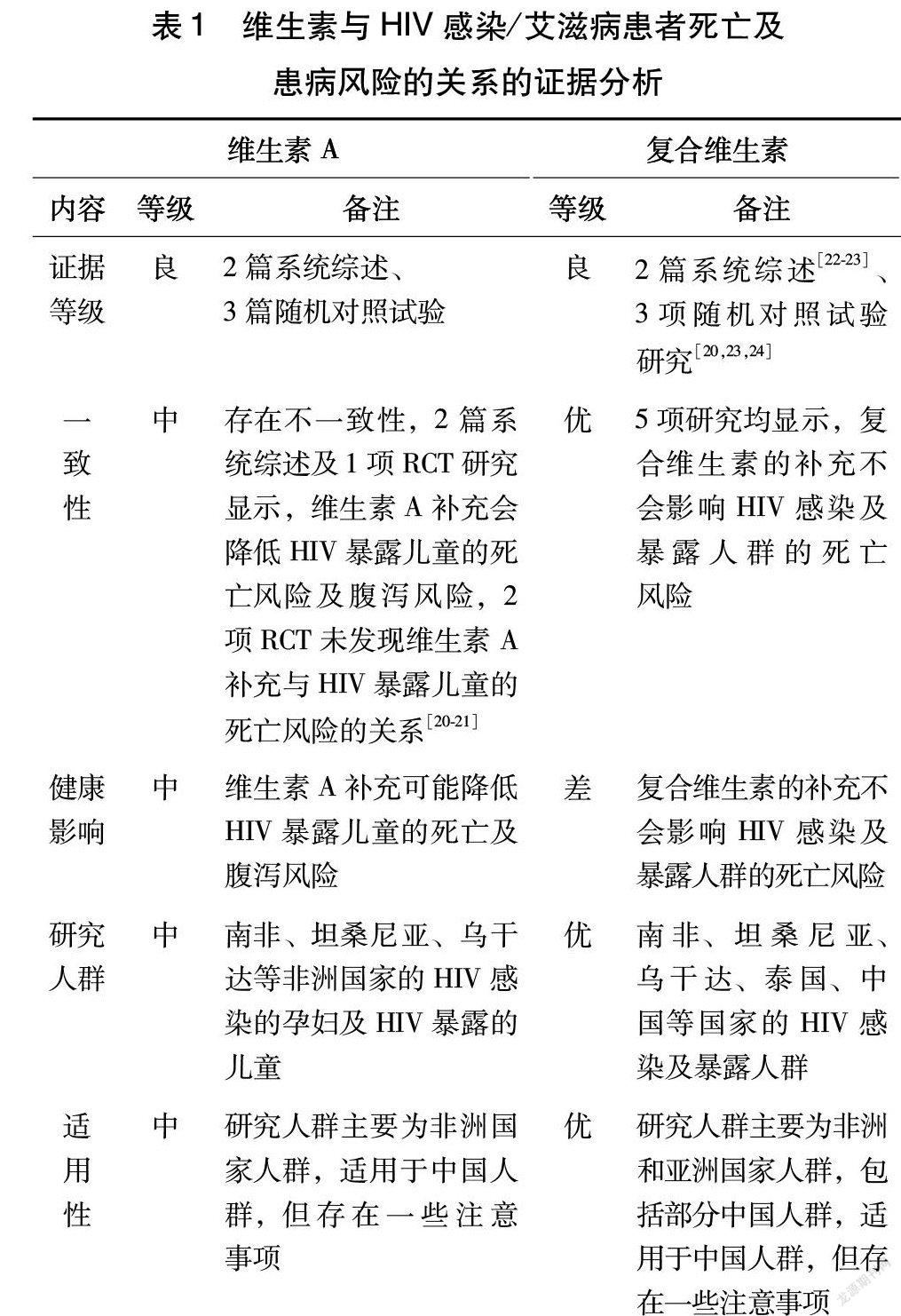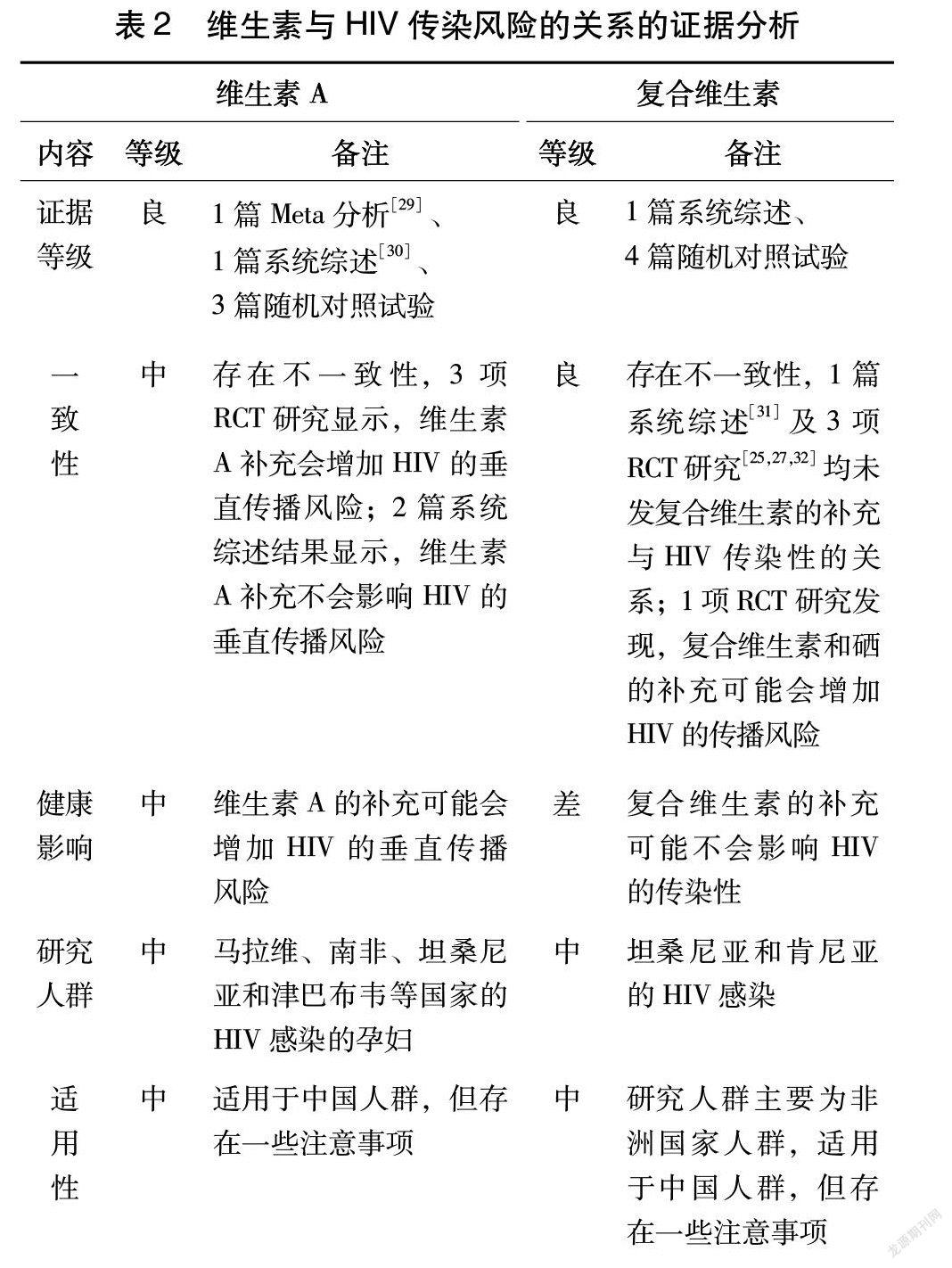维生素在HIV感染/艾滋病患者营养干预中的作用
2022-03-15黄月朱一民刘坦朱文丽
黄月 朱一民 刘坦 朱文丽




摘 要:目的:了解维生素在人类免疫缺陷病毒(HIV)感染/艾滋病患者营养干预中的作用。方法:通过检索查阅国内(万方、中国知网、维普等,1997—2020年)和国外(Cochrane Library、PubMed、Embase等,2002—2020年)的相关文献,共纳入41篇学术论文进行证据体评价(参照WHO推荐的证据评价方案及标准)。结果:HIV感染/艾滋病患者易出现一种或多种维生素不足或缺乏的情况,维生素补充能够改善HIV感染/艾滋病患者的营养状况。维生素A的补充可能降低HIV感染/艾滋病患者的死亡风险、延缓疾病进展以及带来额外的健康收益,但会增加HIV垂直传播风险;烟酸补充可以改善HIV感染/艾滋病患者的血脂水平;补充维生素C、维生素E可以降低HIV感染/艾滋病患者的氧化应激水平;补充维生素D可改善HIV感染/艾滋病患者的骨骼健康,降低冠心病、结核以及肝纤维化的发生风险。结论:复合维生素补充(包括矿物质)可能延缓HIV感染/艾滋病患者的疾病进展以及带来额外的健康收益。
关键词:人类免疫缺陷病毒(HIV);艾滋病(AIDS);维生素;营养素补充
多项研究表明[1-5],人类免疫缺陷病毒(HIV)感染/艾滋病患者营养状况普遍低于健康人群,维生素A、C、D、E及B族维生素不足或缺乏的情况普遍存在,甚至经常同时合并多种维生素的缺乏,但目前尚未有统一的指南明确给出HIV感染/艾滋病患者维生素相关的膳食补充建议。维生素相关的营养素补充剂多用于临床辅助营养治疗,而具体的干预剂量差异极大,难以形成统一的标准。维生素补充是否会影响到HIV感染/艾滋病患者的疾病状态以及是否会产生其他副作用,目前对于这些问题尚没有统一的结论。此次研究的目的在于通过分析HIV感染/艾滋病患者膳食干预及维生素补充剂干预等研究的结果,了解维生素与HIV感染/艾滋病的关系,对HIV感染/艾滋病患者维生素补充的健康收益或风险做出权衡,旨在改善HIV感染/艾滋病患者营养状况,为HIV感染/艾滋病患者膳食营养指南的制定提供证据支持。
1 方法
通过查阅文献,检索自万方、中国知网、维普等数据库1997—2020年期间国内公开发表的相关文献和Cochrane Library、PubMed、Embase等数据库2002—2020年公开发表的相关文献,形成证据体(参考WHO的证据评价方案和标准),进行证据体评价,分析总结维生素在HIV感染/艾滋病营养干预中的作用,给出补充推荐意见。本研究共检索到维生素与HIV感染/艾滋病文献3 246篇,其中中文文献148篇、英文文献3 098篇。排除與本次研究主题无关的文章,研究类型模糊或研究方案表述不清的文章,最后共有41篇文献(其中中文0篇、英文41篇)纳入本次评价。对维生素与HIV感染/艾滋病的关系,分别从HIV感染/艾滋病维生素营养状况、维生素对HIV感染/艾滋病传播风险、疾病进展的关系、健康状况的影响、维生素补充建议方面分析。
2 结果与讨论
2.1 HIV感染/艾滋病患者的维生素营养状况
HIV感染/艾滋病患者维生素不足及缺乏的情况普遍存在,其中维生素A不足及缺乏的发生率从12.5%~59%不等[1-6]、维生素D缺乏的发生率为21.1%~70.3%[7-10],而且艾滋病的相关治疗尤其是基于依非韦伦的抗逆转录治疗会引起HIV感染/艾滋病患者维生素D的缺乏[11-14]。HIV感染体内氧化应激水平升高[15],抗氧化维生素C和E 的消耗增加,有研究结果显示,HIV阳性的儿童血清维生素C的水平下降[16],HIV感染/艾滋病患者容易出现维生素E的缺乏[3,6,16]。
2.2 维生素与HIV感染/艾滋病患者死亡及患病风险的关系
维生素A证据体纳入文献5篇,3篇文献显示,维生素A补充会降低HIV暴露儿童的死亡风险及腹泻风险[17-19]。2015年一项系统综述[17](南非、坦桑尼亚、津巴布韦、乌干达)包含17项随机对照研究(RCT)和6项队列研究,样本量为5 517,每3个月给予200 000国际单位(IU)维生素A或视黄醇当量后,随访15~36个月时,实验组人群的全死因死亡率降低46%,RR=0.54(95%CI:0.30~0.98)。复合维生素补充主要为多种B族维生素与维生素A、维生素D、维生素E中的一种或多种以不同剂量配伍组成,同时可能联合配伍多种矿物质。复合维生素的证据体共纳入5篇文献,研究均未发现复合维生素的补充与HIV感染及暴露人群的死亡风险的关系。证据分析结果显示,HIV感染的孕妇补充维生素A或者HIV暴露儿童补充维生素A,均可能会降低HIV暴露儿童的死亡风险或腹泻发生风险,因此推荐补充(推荐等级为C)。复合维生素的补充并不会影响HIV感染/艾滋病患者的死亡风险,因此推荐补充(推荐等级为B)(表1)。
2.3 维生素与HIV传染性的关系
维生素A与HIV垂直传播关系证据体共纳入了5篇文献,结果不一致。有3篇文献[25-27]显示,HIV感染的孕妇补充维生素A可能会增加HIV垂直传播的风险。2002、2005、2010年的3项RCT(坦桑尼亚)研究结果显示,怀孕12~27周的HIV阳性的孕妇每日口服100 000 IUβ-胡萝卜素和5 000 IU维生素A前体直到分娩,婴儿HIV的感染率也较高(33% VS 25%,P=0.01[26]);发生母婴传播的危险度比RR=1.38[(95%CI:1.09~1.76),P=0.009[28]]。复合维生素证据体共纳入5篇文献,只有1篇RCT研究提示,复合维生素可能增加传染风险[28]。证据分析结果显示,HIV感染的孕妇补充维生素A可能会增加HIV垂直传播的风险,推荐补充(推荐等级为C)同时要权衡其对垂直传播风险的影响;复合维生素的补充可能不会影响HIV 的传染性,推荐补充(推荐等级为C)(表2)。
2.4 維生素与HIV疾病进展关系
维生素A证据体共纳入4文献,其中3篇文献并未发现HIV感染者维生素A的补充与HIV疾病进展的关系[22,32-33]。有研究提示,维生素A缺乏可能是疾病进展的一个危险因素[34]。维生素D证据体共纳入4篇文献,研究提示,低血清25(OH)D水平是HIV疾病进展以及抗病毒失败的独立危险因素[35]。复合维生素的证据体共纳入5篇文献。Fawzi W[32, 36]研究结果显示,怀孕12~27周的HIV感染孕妇每天补充20 mg维生素B1、20 mg 维生素B2、100 mg烟酸、25 mg 维生素B6、0.8 mg叶酸、50μg 维生素B12、500 mg维生素 C、30 mg 维生素E后疾病进展到第3及更高阶段的风险降低[RR=0.72(95%CI:0.58~0.90),P=0.003];疾病进展到第4阶段或出现死亡的风险降低[RR=0.71(95%CI:0.51~0.98,P=0.04)]。证据分析结果显示,维生素A的补充不会影响HIV的疾病进展,推荐补充(推荐等级为B级),维生素D和复合维生素补充可能会延缓HIV感染/艾滋病患者的疾病进展,推荐补充(推荐等级均为C)(表3)。
2.5 维生素对HIV感染/艾滋病患者健康状况的影响
研究显示,维生素A补充可能会为HIV感染/艾滋病患者及HIV暴露人群带来健康收益,包括提高婴儿的出生体重[30]、身长[43]、降低HIV暴露儿童贫血的发生风险[44],所以推荐补充(推荐等级为B)。维生素D对HIV感染/艾滋病患者骨骼系统影响的证据体共纳入4篇文献。维生素D的补充有利于维持HIV感染/艾滋病患者的骨密度,有利于骨的形成[45-46],降低髋骨骨折风险[47]。此外,维生素D缺乏是结核病的独立危险因素[48],与重度肝纤维化相关[49]。维生素的补充可能降低冠状动脉钙化风险[50],推荐补充(推荐等级为B)。复合维生素与HIV暴露儿童的腹泻风险的关系证据体共纳入9篇文献。多项研究表明,怀孕12~17周的HIV感染每天口服20 mg维生素B1、20 mg维生素B2、25 mg维生素B6、100 mg烟酸、50μg维生素B12、5 500 mg维生素C、30 mg维生素E、0.8 mg叶酸,对母婴健康收益大,包括提高血红蛋白浓度[51-52]、体重[26],降低低出生体重风险[31]、腹泻发生率[20]等,推荐补充(推荐等级B)(表4)。
3 结论
HIV感染/艾滋病患者易出现维生素不足或缺乏的情况;维生素补充能够改善HIV感染/艾滋病患者的营养状况;其中维生素A的补充可能降低HIV感染/艾滋病患者的死亡风险、延缓疾病进展[53]以及带来额外的健康收益,但会增加HIV垂直传播风险;烟酸补充可以改善HIV感染/艾滋病患者的血脂水平[54-56];补充维生素C、维生素E可以降低HIV感染/艾滋病患者的氧化应激水平[57-58];补充维生素D可改善HIV感染/艾滋病患者的骨骼健康,降低冠心病、结核以及肝纤维化的发生风险;复合维生素补充(包括矿物质)可能延缓HIV感染/艾滋病患者的疾病进展以及带来额外的健康收益。
参考文献
[1]Webb A,Aboud S,Furtado J,et al.Effect of vitamin supplementation on breast milk concentrations of retinol,carotenoids and tocopherols in HIV-infected Tanzanian women[J].European Journal of Clinical Nutrition,2009,63(3):332-339.
[2]Shivakoti R,Christian P,Yang WT,et al.Prevalence and risk factors of micronutrient deficiencies pre- and post-antiretroviral therapy (ART)among a diverse muLticountry cohort of HIV-infected adults[J].Clin Nutr,2016,35(1):183-189.
[3]Mehta S,Spiegelman D,Aboud S,et al.Lipid-soluble vitamins A,D,and E in HIV-infected pregnant women in Tanzania[J].Eur J Clin Nutr,2010,64(8):808-817.
[4]Balfour L,Spaans JN,Fergusson D,et al.Micronutrient deficiency and treatment adherence in a randomized controlled trial of micronutrient supplementation in ART-naive persons with HIV[J].PLoS One,2014,9(1):e85607.
[5]Baeten JM,McClelland RS,Richardson BA,et al.Vitamin A deficiency and the acute phase response among HIV-1-infected and -uninfected women in Kenya[J].J Acquir Immune Defic Syndr,2002,31(2):243-249.
[6]Monteiro JP,Cruz ML,Mussi-Pinhata MM,et al.Vitamin A,vitamin E,iron and zinc status in a cohort of HIV-infected mothers and their uninfected infants[J].Rev Soc Bras Med Trop,2014,47(6):692-700.
[7]Zhang L,Tin A,Brown T,et al.Vitamin D Deficiency and Metabolism in HIV-Infected and HIV-Uninfected Men in the Multicenter AIDS Cohort Study[J].AIDS Research and Human Retroviruses,2017,33(3):261-270.
[8]Crutchley RD,Gathe J,Mayberry C,et al.Risk factors for vitamin D deficiency in HIV-infected patients in the south central United States[J].AIDS Res Hum Retroviruses,2012,28(5):454.
[9]Kim JH,Gandhi V,Psevdos G,et al.Evaluation of vitamin D levels among HIV-infected patients in New York City[J].AIDS Res Hum Retroviruses,2012,28(3):235-241.
[10]Dao CN,Patel P,Overton ET,et al.Low vitamin D among HIV-infected adults:prevalence of and risk factors for low vitamin D levels in a cohort of HIV-infected adults and comparison to prevalence among aduLts in the US general population[J].Clin Infect Dis,2011,52(3):396-405.
[11]Nylen H,Habtewold A,Makonnen E,et al.Prevalence and risk factors for efavirenz-based antiretroviral treatment-associated severe vitamin D deficiency:a prospective cohort study[J].Medicine (Baltimore),2016,95(34):4631.
[12]Havers FP,Detrick B,Cardoso SW,et al.Change in vitamin d levels occurs early after antiretroviral therapy initiation and depends on treatment regimen in resource-limited settings[J].PLoS One,2014,9(4):951-964.
[13]Welz T,Childs K,Ibrahim F,et al.Efavirenz is associated with severe vitamin D deficiency and increased alkaline phosphatase[J].Aids,2010,24(12):1923-1928.
[14]Allavena C,Delpierre C,Cuzin L,et al.High frequency of vitamin D deficiency in HIV-infected patients:effects of HIV-related factors and antiretroviral drugs[J].Antimicrob Chemother,2012,67(9):2222-2230.
[15]Lopez O,Bonnefont-Rousselot D,Edeas M,et al.CouLd antioxidant supplementation reduce antiretroviral therapy-induced chronic stable hyperlactatemia?[J].Biomed Pharmacother,2003,57(3-4):113-116.
[16]Srinivas A,Dias BF.Antioxidants in HIV positive children[J].Indian J Pediatr,2008,75(4):347-350.
[17]McHenry MS,Dixit A,Vreeman RC.A Systematic Review of Nutritional Supplementation in HIV-Infected Children in Resource-Limited Settings[J].Int Assoc Provid AIDS Care,2015,14(4):313-323.
[18]Semba RD,Ndugwa C,Perry RT,et al.Effect of periodic vitamin A supplementation on mortality and morbidity of Human immunodeficiency virus-infected children in Μganda:a controlled clinical trial[J].Nutrition,2005,21(1):25-31.
[19]Irlam JH,Siegfried N,Visser ME,et al.Micronutrient supplementation for children with HIV infection[J].Cochrane Database of Systematic Reviews,2013(10):CD010666.
[20]Khavari N,Jiang H,Manji K,et al.Maternal multivitamin supplementation reduces the risk of diarrhoea among HIV-exposed children through age 5 years[J].Int Health,2014,6(4):298-305.
[21]Kawai K,Msamanga G,Manji K,et al.Sex differences in the effects of maternal vitamin supplements on mortality and morbidity among children born to HIV-infected women in Tanzania[J].Br J Nutr,2010,103(12):1784-1791.
[22]Visser ME,Durao S,Sinclair D,et al.Micronutrient supplementation in adults with HIV infection[J].Cochrane Database of Systematic Reviews,2017(5):CD003650.
[23]Duggan C,Manji KP,Kupka R.,et al.Multiple micronutrient supplementation in Tanzanian infants born to HIV-infected mothers:a randomized,double-blind,placebo-controlled clinical trial[J].Am J Clin Nutr,2012,96(6):1437-1446.
[24]Ndeezi G,Tylleskr T,Ndugwa CM,et al.Effect of multiple micronutrient supplementation on survival of HIV-infected children in Uganda:a randomized,controlled trial[J].Journal of The International AIDS Society,2010(13):18.
[25]Villamor E,KouLinska IN,Aboud S,et al.Effect of vitamin supplements on HIV shedding in breast milk[J].Am J Clin Nutr,2010,92(4):881-886.
[26]Villamor E,Saathoff E,Bosch RJ,et al.Vitamin supplementation of HIV-infected women improves postnatal child growth[J].Am J Clin Nutr,2005,81(4):880-888.
[27]Fawzi WW,Msamanga GI,Hunter D,et al.Randomized trial of vitamin supplements in relation to transmission of HIV-1 through breastfeeding and early child mortality[J].Aids,2002,16(14):1935-1944.
[28]McClelland R,Baeten J,Overbaμgh J,et al.Micronutrient supplementation increases genital tract shedding of HIV-1 in women:results of a randomized trial[J].Journal of Acquired Immune Deficiency Syndromes,2004,37(5):1657-1663.
[29]Wiysonge CS,Ndze VN,Kongnyuy EJ,et al.Vitamin A supplements for reducing mother-to-child HIV transmission[J].Cochrane Database of Systematic Reviews,2017,9(9):CD003648.
[30]Kongnyuy EJ,Wiysonge CS,Shey MS.A systematic review of randomized controlled trials of prenatal and postnatal vitamin A supplementation of HIV-infected women[J].Int J Gynaecol Obstet,2009,104(1):5-8.
[31]Siegfried N,Irlam JH,Visser ME,et al.Micronutrient supplementation in pregnant women with HIV infection[J].Cochrane Database of Systematic Reviews,2012(3):CD009755.
[32]Fawzi WW,Msamanga GI,Spiegelman D,et al.A randomized trial of multivitamin supplements and HIV disease progression and mortality[J].N Engl J Med,2004,351(1):23-32.
[33]Motswagole BS,Mongwaketse TC,Mokotedi M,et al.The efficacy of micronutrient-fortified sorghum meal in improving the immune status of HIV-positive adults[J].Ann Nutr Metab,2013,62(4):323-330.
[34]Baeten JM,McClelland RS,Wener MH,et al.Relationship between markers of HIV-1 disease progression and serum beta-carotene concentrations in Kenyan women[J].Int J STD AIDS,2007,18(3):202-206.
[35]Havers FP,Detrick B,Cardoso SW,et al.Change in vitamin D levels occurs early after antiretroviral therapy initiation and depends on treatment regimen in resource-limited settings[J].PLoS One,2014,9(4):951-964.
[36]Fawzi WW,Msamanga GI,Wei R,et al.Effect of providing vitamin supplements to Human immunodeficiency virus-infected,lactating mothers on the child’s morbidity and CD4+T cell counts[J].Clin Infect Dis,2003,36(8):1053-1062.
[37]Stallings V,Schall J,Hediger M,et al.High-dose vitamin D3 supplementation in children and young adults with HIV:a randomized,placebo-controlled trial[J].Pediatric Infectious Disease Journal,2015,34(2):32-40.
[38]Kakalia S,Sochett E,Stephens D,et al.Vitamin D supplementation and CD4 count in children infected with Human Immunodeficiency Virus[J].Journal of Pediatrics,2011,159(6):951-957.
[39]Arpadi S,McMahon D,Abrams E,et al.Effect of bimonthly supplementation with oral cholecalciferol on serum 25-hydroxyvitamin D concentrations in HIV-infected children and adolescents[J].Pediatrics,2009,123(1):121-126.
[40]Baum M,Campa A,Lai S,et al.Effect of micronutrient supplementation on disease progression in asymptomatic,antiretroviral-naive,HIV-infected adults in Botswana:a randomized clinical trial[J].JAMA,2013,310(20):2154-2163.
[41]Fawzi W,Msamanga G,Wei R,et al.Effect of providing vitamin supplements to Human Immunodeficiency Virus-infected,lactating mothers on the child’s morbidity and CD4+T cell counts[J].Clinical Infectious Diseases,2003,36(8):1053-1062.
[42]Isanaka S,Mugusi F,Hawkins C,et al.Effect of high-dose vs standard-dose multivitamin supplementation at the initiation of HAART on HIV disease progression and mortality in Tanzania:a randomized controlled trial[J].JAMA,2012,308(15):1535-1544.
[43]Villamor E,Msamanga G,Spiegelman D,et al.Effect of multivitamin and vitamin A supplements on weight gain during pregnancy among HIV-1-infected women[J].Am J Clin Nutr,2002,76(5):1082-1090.
[44]Kumwenda N,Miotti PG,Taha TE,et al.Antenatal vitamin A supplementation increases birth weight and decreases anemia among infants born to Human Immunodeficiency Virus-infected women in Malawi[J].Clinical Infect Disease.2002,35(5):618-624.
[45]Etminani-Esfahani M,Khalili H,Jafari S,et al.Effects of vitamin D supplementation on the bone specific biomarkers in HIV infected individuals under treatment with efavirenz[J].BMC Res Notes,2012,5(1):204.
[46]Bang U,Kolte L,Hitz M,et al.The effect of cholecalciferol and calcitriol on biochemical bone markers in HIV type 1-infected males:results of a clinical trial[J].AIDS Research and Human Retroviruses,2013,29(4):658-664.
[47]Overton ET,Chan ES,Brown TT,et al.High-Dose vitamin D and calcium attenuates bone loss with ART initiation:results from ACTG A5280[J].Topics in Antiviral Medicine,2014,22(1):66-67.
[48]Tenforde MW,Yadav A,Dowdy DW,et al.Vitamin A and D deficiencies associated with incident tuberculosis in HIV-Infected patients initiating antiretroviral therapy in multinational case-cohort study[J].J Acquir Immune Defic Syndr,2017,75(3):71-79.
[49]Terrier B,Carrat F,Geri G,et al.Low 25-OH vitamin D serum levels correlate with severe fibrosis in HIV-HCV co-infected patients with chronic hepatitis[J].Journal of hepatology,2011,55(4):756-761.
[50]Lai S,Fishman EK,Gerstenblith G,et al.Vitamin D deficiency is associated with coronary artery calcification in cardiovascuLarly asymptomatic African Americans with HIV infection[J].Vasc Health Risk Manag,2013,(9):493-500.
[51]Fawzi W,Msamanga G,Kupka R,et al.MuLtivitamin supplementation improves hematologic status in HIV-infected women and their children in Tanzania[J].American Journal of Clinical Nutrition,2007,85(5):1335-1343.
[52]Liu E,Dμggan C,Manji K,et al.MuLtivitamin supplementation improves haematologic status in children born to HIV-positive women in Tanzania[J].Journal of the International AIDS Society,2013,16(1):8022.
[53]孫京,朱一民,刘坦,等.维生素A营养状况与AIDS发生发展的系统综述[J].营养学报,2020,42(3):296-300.
[54]Dube MP,Wu JW,Aberg JA,et al.Safety and efficacy of extended-release niacin for the treatment of dyslipidaemia in patients with HIV infection:AIDS clinical trials group study A5148[J].Antivir Ther,2006,11(8):1081-1089.
[55]Gerber MT,Mondy KE,Yarasheski KE,et al.Niacin in HIV-infected individuals with hyperlipidemia receiving potent antiretroviral therapy[J].Clin Infect Dis,2004,39(3):419-425.
[56]Lin C,Grandinetti A,Shikuma C,et al.The effects of extended release niacin on lipoprotein sub-particle concentrations in HIV-infected patients[J].Hawai’i Journal of Medicine & Public Health,2013,72(4):123-127.
[57]Merenstein D,Wang C,Gandhi M,et al.An investigation of the possible interaction between the use of vitamin C and highly active antiretroviral therapy (HAART)adherence and effectiveness in treated HIV+ women[J].Complement Ther Med,2012,20(4):222-227.
[58]Jarμga P,Jarμga B,Gackowski D,et al.Supplementation with antioxidant vitamins prevents oxidative modification of DNA in lymphocytes of HIV-infected patients[J].Free Radical Biology & Medicine,2002,32(5):414-420.
Role of Vitamins in Nutritional Intervention in HIV Infection / AIDS Patients
HUANG Yue1,2,ZHU Yi-min2,LIU Tan2,ZHU Wen-li2
(1Sixth Medical Center of the General Hospital of the PLA,Beijing 100048,China;2Department of Nutrition and Food Hygiene,School of Public Health ,Peking University ,Beijing 100191,China)
Abstract:Objective To know the role of vitamins in the nutritional intervention in HIV infection / AIDS patients.Method This study has reviewed relevant documents at home (Wan Fang database, China National Knowledge Infrastructure, Weip database, 1997—2020) and abroad (Cochrane library, PubMed, Embase, 2002—2020) , a total of 41 academic papers for evidence (refer to the evidence evaluation plan and standards recommended by WHO). Result HIV-infected / AIDS patients have prone to one or more cases of vitamins or lack of lack.Vitamin supplements can improve the nutritional status of HIV-infected / AIDS patients.Vitamin A supplements may reduce the risk of death of HIV-infected / AIDS patients and delay the progress of the disease for bringing additional health benefits, but they will increase HIV vertical propagation risk. Niacin supplement can improve blood lipid levels in HIV-infected / AIDS patients.Supplement vitamin C, E can reduce HIV-infected / AIDS patients with oxidative stress level .Supplemental vitamin D can improve the risk of bone health of HIV / AIDS patients, reduce coronary heart disease, tuberculosis, and liver fibrosis. Conclusion Compound vitamin supplements (including minerals) may delay the progress of HIV-infected / AIDS patients and bring additional Healthy benefits.
Keywords:HIV;AIDS; vitamin; nutrient supplement
作者簡介: 黄 月(1992—),女,在读硕士研究生,临床营养师,研究方向:妇幼营养。
通信作者: 朱文丽(1973—),女,博士,教授,研究方向:妇幼营养、儿童营养。
3997500338202
